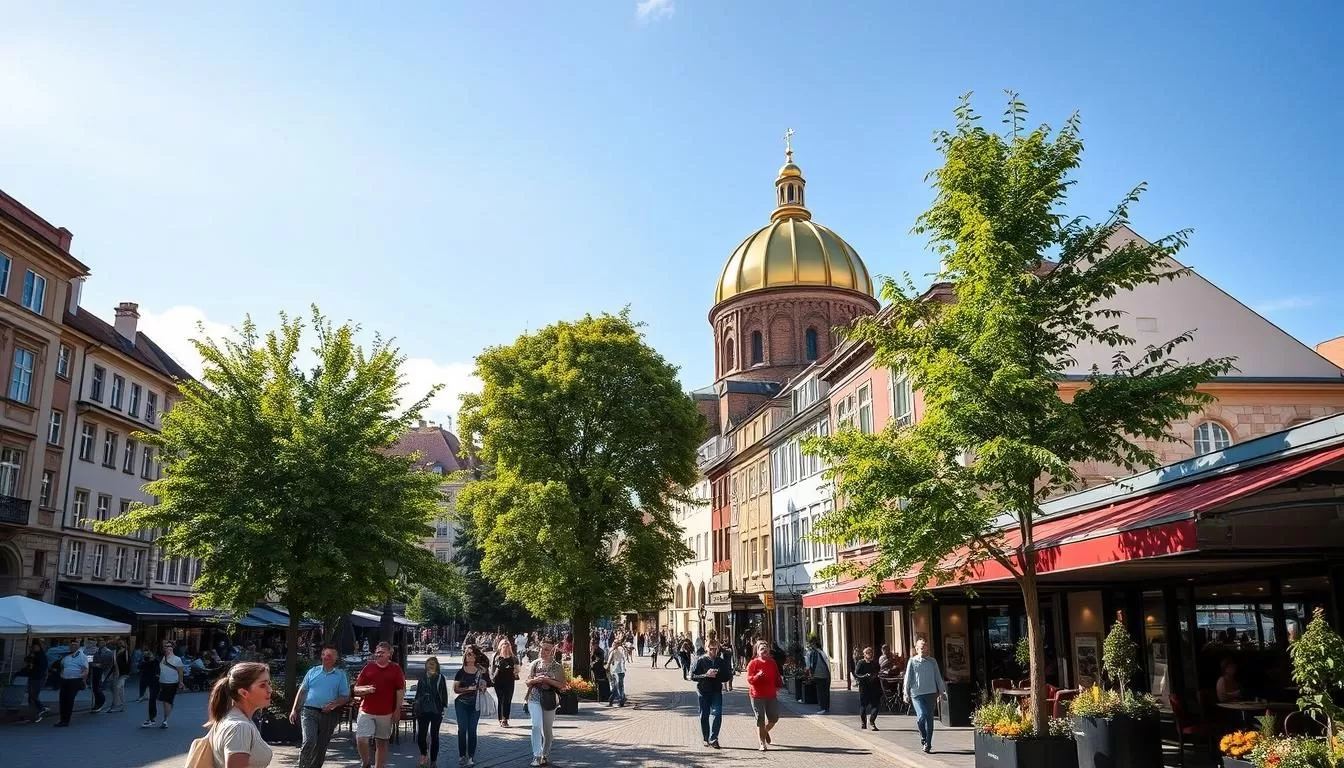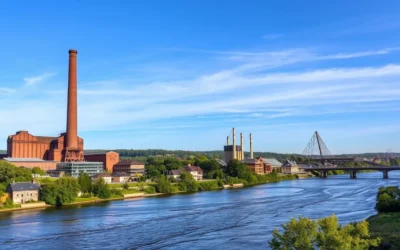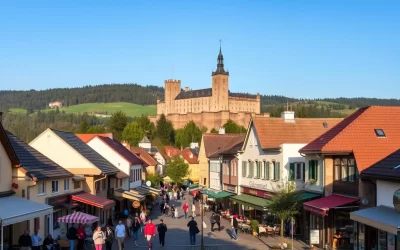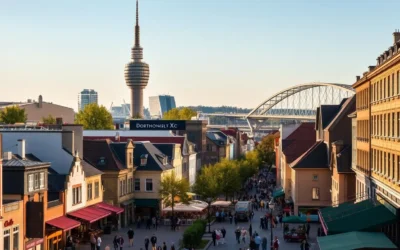✓ Accommodations✓ Flights✓ Rental Cars✓ Tours & Activities
Choosing the right time to travel can make all the difference. Whether you’re drawn to sunny summer days or the charm of winter markets, understanding the weather and local events is key. Each season offers unique experiences, from blooming landscapes in spring to festive celebrations in fall.
During summer, the temperature is warm, perfect for exploring outdoor sites. However, this is also the peak travel period, so expect larger crowds. If you prefer milder weather and fewer tourists, consider visiting in spring or fall. These shoulder seasons balance pleasant conditions with vibrant festivals like Oktoberfest.
No matter when you go, planning ahead ensures you’ll enjoy the best of what this destination has to offer. Let’s dive into the details to help you decide the ideal time for your trip.
Introduction to Timing Your Visit in Dresden
Timing your visit can transform your travel experience. The time of year you choose to explore a city like this one impacts everything from the weather to the local events you’ll enjoy. Whether you’re drawn to sunny summer days or the charm of winter markets, planning around the season ensures you make the most of your trip.
Why the Right Time Matters for Your Trip
Choosing the best time to visit isn’t just about avoiding rain or snow. It’s about aligning your travel with the rhythms of the place. Subtle differences in temperature and weather can make sightseeing more enjoyable. For example, spring offers mild conditions perfect for outdoor adventures, while fall brings vibrant festivals like Oktoberfest.
An Overview of Seasonal Benefits
Each season has its unique charm. Spring and early summer are ideal for those who prefer milder weather and fewer crowds. These periods also coincide with cultural events and local celebrations. On the other hand, summer is perfect for exploring outdoor sites, though it’s the peak travel period.
Understanding these seasonal changes helps you plan a trip that’s both enjoyable and memorable. Whether you’re here for the festivals or the scenic beauty, timing your visit right ensures you’ll have an unforgettable experience.
Understanding Germany’s Four Seasons and Regional Weather
Germany’s seasons bring unique charm to every visit. Each season transforms the region with distinct weather patterns and cultural highlights. Whether you’re drawn to snowy landscapes or blooming gardens, understanding these changes helps you plan a memorable trip.
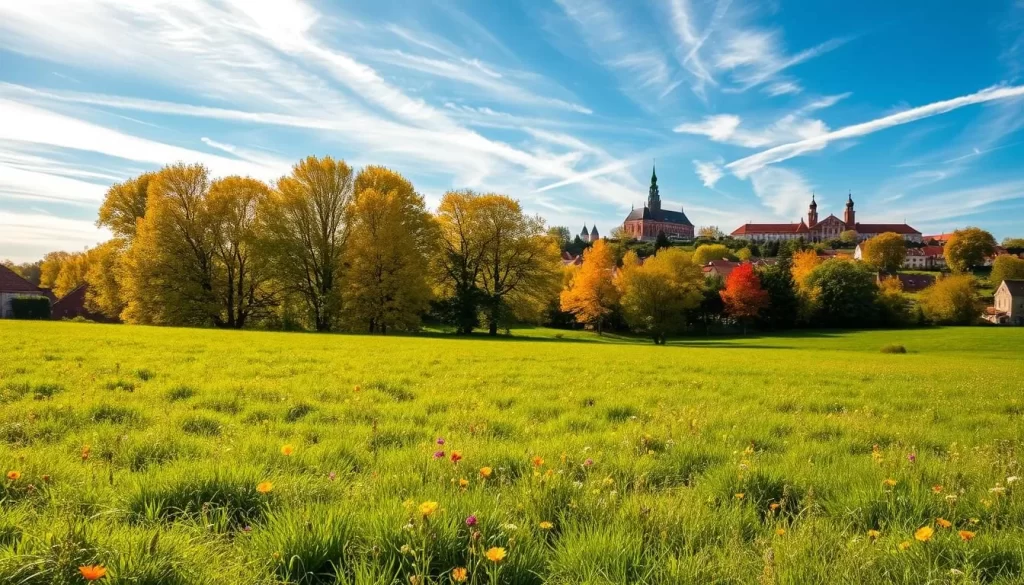
Winter Magic and Snowy Delights
Winter in Germany is a magical time. Snow blankets the landscape, creating a picturesque setting for outdoor activities. Average temperatures range from -2 to 4°C (28 to 39°F), making it ideal for winter sports like skiing and ice skating.
This season also brings festive cheer. Christmas markets fill the air with the scent of mulled wine and roasted chestnuts. Cozy outdoor gatherings and twinkling lights make it a perfect time to explore the region’s cultural charm.
Spring Blooms and Occasional Showers
Spring revives the region with blossoming landscapes and fresh temperatures. Average highs in March range from 5 to 12°C (41 to 54°F), offering mild conditions for outdoor adventures. However, occasional showers are common, so packing a light raincoat is wise.
This season is a celebration of renewal. Parks and gardens burst with color, making it a great time for scenic walks. The balance between gentle rain and sunny days adds to the charm of spring travel.
| Season | Average Temperature | Key Highlights |
|---|---|---|
| Winter | -2 to 4°C (28 to 39°F) | Snowy landscapes, Christmas markets, winter sports |
| Spring | 5 to 12°C (41 to 54°F) | Blooming gardens, mild weather, occasional rain |
Understanding these seasonal changes ensures you’ll enjoy the best of what this region has to offer. Whether you’re here for the festivals or the scenic beauty, timing your visit right makes all the difference.
Dresden, Germany: Best Months for a Weather-Savvy Trip
May offers a perfect blend of pleasant weather and fewer tourists, making it an ideal time to explore. This shoulder season combines mild temperatures with blooming landscapes, creating a picturesque setting for your trip.
May: The Ideal Shoulder Season
During May, the weather is comfortably warm, with average highs ranging from 59 to 68°F (15 to 20°C). This makes it perfect for outdoor activities like strolling through gardens or visiting historic sites. Unlike the peak summer months, you’ll avoid the intense heat and large crowds.
Spring is in full bloom, adding vibrant colors to the destination. Parks and open spaces come alive, offering a refreshing backdrop for your adventures. The mild temperature also means you can enjoy longer days without feeling overwhelmed by the heat.
Balancing Mild Temperatures and Fewer Crowds
One of the biggest advantages of visiting in May is the manageable number of tourists. You’ll have more space to explore landmarks and attend local events at a relaxed pace. This is especially beneficial if you’re looking to immerse yourself in the culture without the hustle and bustle of peak travel periods.
Local festivals and spring celebrations add to the charm of this month. From art exhibitions to food markets, there’s always something happening. These events provide a unique opportunity to experience the destination like a local.
Practical benefits include lower prices for accommodations and fewer crowds at popular attractions. This makes May not only a pleasant but also a cost-effective time to visit. Whether you’re here for the scenery or the culture, May ensures a memorable and enjoyable trip.
Exploring Iconic Festivals and Seasonal Events
Experiencing iconic festivals and seasonal events can elevate your travel journey. These celebrations offer a glimpse into the heart of local culture, blending tradition with modern charm. Whether it’s the magic of winter or the vibrancy of summer, each event brings its own unique flavor.
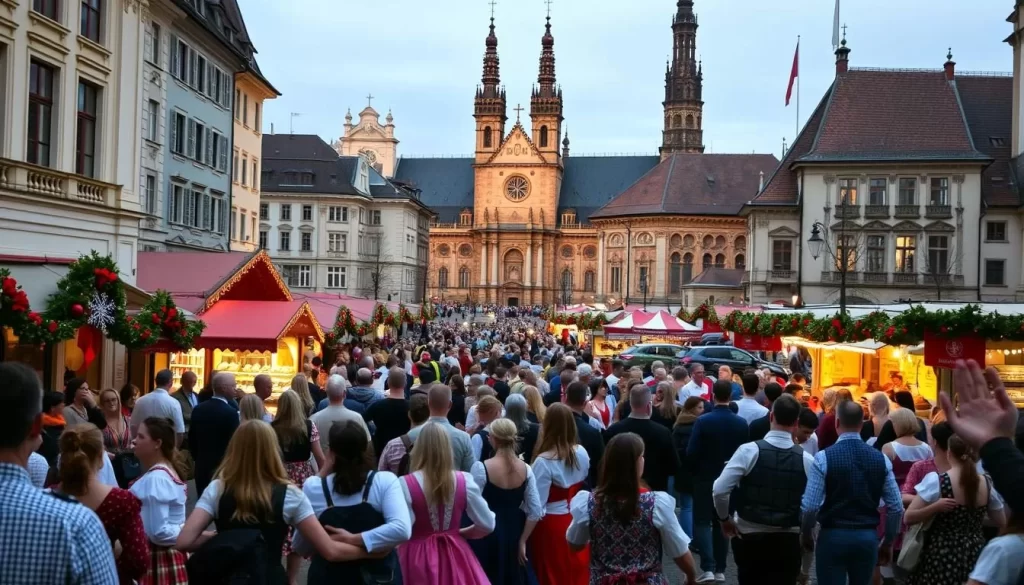
Celebrating Christmas Markets and Winter Festivities
Winter transforms the city into a wonderland, with Christmas markets at the center of the magic. Stroll through rows of stalls offering handmade crafts, warm drinks like Glühwein, and traditional treats like Lebkuchen. The festive atmosphere is perfect for creating lasting memories.
These markets are more than just shopping destinations. They’re a celebration of community, with twinkling lights, live music, and joyful gatherings. Visiting during the early afternoon on weekdays can help you avoid the crowds and enjoy a more relaxed experience.
Embracing Local Parades and Outdoor Celebrations
Beyond winter, local parades and outdoor festivals bring the city to life. From colorful carnivals to cultural parades, these events showcase the region’s diversity and creativity. They’re a great way to connect with locals and immerse yourself in the vibrant culture.
Seasonal celebrations often feature traditional food, music, and crafts. Whether it’s a summer street festival or a springtime parade, these events offer a chance to experience the destination like a local. Plan ahead to make the most of your time and enjoy these unforgettable moments.
Weather Insights for Major German Cities and Yearly Trends
Weather patterns vary widely across Germany’s urban centers. Each city has its unique climate, influenced by geography and regional trends. Understanding these differences can help you plan a smoother and more enjoyable trip.
Comparing Urban Weather Patterns
Berlin, Munich, and Hamburg each offer distinct weather experiences. Berlin’s temperature ranges from -2°C (28°F) in winter to 25°C (77°F) in summer. However, it’s known for variable rain, so always carry an umbrella.
Munich enjoys more stable conditions, making it ideal for outdoor events and festivals. Its proximity to the Alps brings cooler evenings, even in summer. Hamburg, on the other hand, experiences coastal influences, leading to breezy and unpredictable weather.
Regional Variations: Berlin, Munich, and Beyond
Each region has its charm. Berlin’s variability adds excitement to your day, while Munich’s consistency ensures reliable plans. Hamburg’s coastal vibe offers a refreshing change, though it’s wise to check forecasts frequently.
These differences highlight the importance of tailoring your itinerary to the destination. Whether you’re exploring historic sites or enjoying local culture, knowing the weather ensures you’re prepared.
How Forecasts Impact Your Daily Plans
Weather forecasts are your best friend when traveling. They help you adjust your plans, whether it’s swapping an outdoor activity for a museum visit or packing extra layers for a chilly evening.
Staying informed about local climate trends also enhances your experience. For example, planning around rain in Berlin or enjoying Munich’s sunny afternoons can make your travel more enjoyable.
Practical tips like packing a versatile wardrobe and checking forecasts daily ensure you’re ready for any weather surprises. This way, you can focus on enjoying your trip without unexpected disruptions.
Practical Travel Tips for a Successful Trip
Smart preparation can make your travel experience smoother and more enjoyable. Whether you’re exploring bustling cities or serene landscapes, having the right essentials and practical know-how ensures a stress-free journey. Let’s dive into some tips to help you make the most of your trip.

Packing Essentials for Changing Weather
Packing for unpredictable weather is key. Layering is your best friend, especially when temperatures can shift throughout the day. Start with a lightweight base, add a warm sweater, and top it off with a waterproof jacket. This approach keeps you comfortable in any condition.
Don’t forget comfortable walking shoes. Whether you’re strolling through cobblestone streets or hiking scenic trails, your feet will thank you. A compact umbrella or raincoat is also a must, as sudden showers can happen any time of year.
Local Transportation and Currency Insights
Navigating public transportation is often the most efficient way to explore. In many destinations, daily or weekly passes offer unlimited travel and can save you money. For example, cities like have extensive networks that make getting around a breeze.
When it comes to currency, it’s wise to carry a mix of cash and cards. While cards are widely accepted in urban areas, smaller shops or rural spots may prefer cash. Check exchange rates in advance and consider using a travel-friendly card to avoid extra fees.
Planning ahead ensures you’re ready for anything. Whether it’s adjusting your itinerary for unexpected weather or budgeting for local experiences, a little preparation goes a long way. With these tips, you’re set for a smooth and enjoyable travel adventure.
Navigating Crowds and Seasonal Pricing Strategies
Traveling during off-peak periods offers a more relaxed and budget-friendly experience. By avoiding the busiest times, you can enjoy your trip without the stress of large crowds or high prices. Whether you’re exploring a bustling destination or a serene retreat, timing your visit wisely makes all the difference.
Avoiding Peak Tourist Chaos
Peak travel seasons, like summer, often mean packed attractions and higher costs. To avoid this, consider visiting during shoulder seasons like spring or early fall. These periods offer milder weather and fewer tourists, making it easier to explore popular sites at your own pace.
Planning your itinerary around quieter days can also help. For example, visiting attractions midweek or early in the morning reduces the chance of long lines. Flexibility is key to navigating crowded destinations without feeling overwhelmed.
Maximizing Budget with Off-Peak Travel
Off-peak travel isn’t just about avoiding crowds—it’s also a smart way to save money. Airfare and accommodations are often significantly cheaper during these periods. For instance, January and February are some of the most affordable months to visit many destinations.
Shoulder seasons also strike a balance between pleasant weather and lower prices. By aligning your travel plans with these periods, you can enjoy a memorable trip without breaking the bank. Always check local events and forecasts to make the most of your visit.
Cultural Experiences and Outdoor Adventures in Dresden
Dresden’s blend of history and modern charm offers a unique travel experience. Whether you’re exploring its iconic landmarks or enjoying a leisurely stroll along the river, this city has something for everyone. From historic museums to scenic walks, your trip will be filled with unforgettable moments.
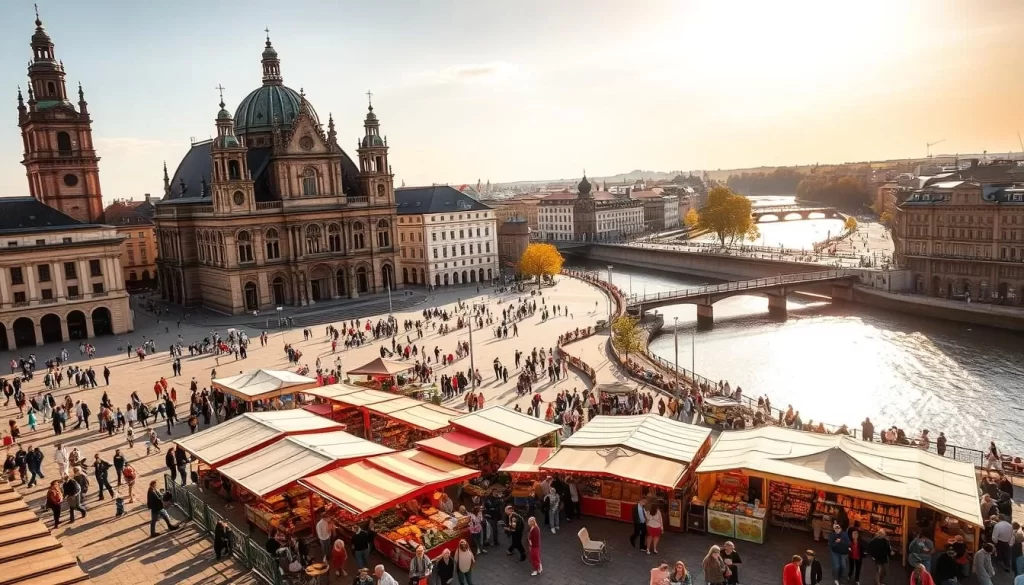
Exploring Historic Sites and Museums
Dresden is home to some of the most impressive historic sites in Europe. The Frauenkirche, with its stunning dome, is a must-visit. This architectural masterpiece stands as a symbol of the city’s resilience and restoration after WWII.
For art enthusiasts, the Zwinger Palace offers a glimpse into the culture and history of the region. Its galleries house collections ranging from Old Masters to porcelain. Guided tours are available to help you uncover the stories behind these treasures.
Enjoying Outdoor Dining and Scenic Walks
When the weather is pleasant, outdoor dining along the Elbe River is a treat. Many restaurants offer local food with a view, making it a perfect way to spend a day. Try traditional Saxon dishes like Sauerbraten or indulge in a slice of Eierschecke, a local dessert.
For a relaxing afternoon, take a scenic walk through the Großer Garten. This expansive park is ideal for picnics or simply enjoying the fresh air. The interplay of nature and history creates a serene atmosphere that’s hard to beat.
| Attraction | Highlight |
|---|---|
| Frauenkirche | Iconic dome and historic significance |
| Zwinger Palace | Art collections and baroque architecture |
| Elbe River Restaurants | Outdoor dining with scenic views |
| Großer Garten | Expansive park for leisurely walks |
Whether you’re exploring museums or enjoying the outdoors, Dresden offers a perfect mix of culture and relaxation. Plan your visit to make the most of this vibrant destination.
Planning Your Flexible Itinerary Around Events
Crafting a flexible itinerary around events ensures you make the most of your travel experience. Whether you’re drawn to lively festivals or serene moments of exploration, balancing both can create a memorable trip. Start by researching local events and aligning them with your interests.
Balancing Major Festivals with Quiet Moments
Major festivals like Oktoberfest attract large crowds and vibrant energy. While these are must-see events, it’s important to balance them with quieter activities. For example, after a bustling day at a festival, consider a peaceful walk through a local park or a visit to a museum.
Flexibility is key. Unexpected changes, like weather shifts or schedule adjustments, can disrupt plans. Allowing free time in your itinerary ensures you can adapt without stress. This approach also lets you explore hidden gems at your own pace.
Creating a Personalized Schedule
Your itinerary should reflect your unique interests. If you love culture, prioritize events like parades or music performances. For a more relaxed trip, focus on scenic walks and outdoor dining. Tailoring your schedule ensures you enjoy every moment.
Consider the timing of events. Visiting during shoulder seasons, like late September or early October, offers a mix of pleasant weather and fewer crowds. This makes it easier to engage with local culture without feeling overwhelmed.
| Activity | Tip |
|---|---|
| Major Festivals | Plan for peak times but allow downtime afterward. |
| Quiet Moments | Explore parks, museums, or scenic spots for relaxation. |
| Flexibility | Leave free time to adapt to changes or unexpected opportunities. |
| Personalization | Focus on activities that match your interests and pace. |
By balancing lively events with peaceful exploration, you’ll create a trip that’s both exciting and rejuvenating. For more insights into cultural challenges in event planning, check out this informative resource.
Conclusion
Planning your journey with seasonal insights can make it unforgettable. By aligning your visit with optimal weather and vibrant events, you’ll enjoy a richer travel experience. Each season offers unique opportunities, from festive markets to blooming landscapes.
Understanding regional climate patterns helps you pack smartly and plan efficiently. Visiting during shoulder periods ensures fewer crowds and lower prices, making your trip both enjoyable and budget-friendly. Flexibility in your itinerary allows you to adapt to unexpected changes or discover hidden gems.
Use this guide as a roadmap to create a balanced and memorable adventure. Whether you’re drawn to culture, history, or outdoor exploration, careful timing transforms your journey into something truly special. Start planning today and make the most of every moment.
The above is subject to change.
Check back often to TRAVEL.COM for the latest travel tips and deals.
